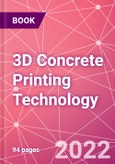The book presents a detailed comparison between traditional construction techniques and 3D printing construction. The comparison focuses on four primary parameters: mechanism, composition, time and cost. The operational details of each technology (cast-in situ, pre-stress, post-tension) are reviewed and comparison criteria for all techniques are formulated. In conclusion, 3D printing seems to be well on its way to transform the whole construction industry.
About the Author
Dr. Tejwant Singh Brar is Senior Professor in School of Art & Architecture, Sushant University, Gurugram, Haryana, India and founding member of Architecture and Planning office Map Solutions, Patiala, Punjab India. He was awarded Ministry of Human Resource Development (MHRD) Institute Assistantship for pursuing Ph.D. in Architecture from Indian Institute of Technology (IIT), Roorkee, Roorkee, Uttarakhand, India. He is an Architect and Urban Planner having 23 years of Teaching, Research and Professional experience in the field of Architecture, Building Technology and Urban Planning. His areas of interest are Urban Water Resource Management, GIS, Remote Sensing, Urban Planning and Building Technology etc. He has published around 70 Research papers in various International Journals, Book Chapters and Conferences.
Dr. Mohammad Arif Kamal is an architect and academician having around 20 years of Teaching, Research and Professional experience in the field of Architecture and Building Construction Technology. He was awarded a Ministry of Human Resource Development (MHRD) Institute Assistantship for pursuing both M. Arch. and Ph.D. in Architecture from Indian Institute of Technology Roorkee (IITR), Roorkee, Uttarakhand, India. Dr. Kamal is presently working as an Associate Professor in Aligarh Muslim University, Aligarh, Uttar Pradesh, India. His area of research includes Environmental Design, Climate Responsive Architecture, Sustainable Architecture, and Building Technology, Traditional Architecture etc. He has published around 80 Research papers in various International Journals and Conferences. He has published 3 books and 10 book chapters. Dr. Kamal is Editor-in-Chief of 5 International journals related to Architecture, and Building Technology. He has also edited 5 Special Topic Volume (Scopus indexed) related to Sustainable Building Materials, published by Trans Tech Publications, Switzerland.
Shubham Singh is an undergraduate student of Architecture at School of Art & Architecture, Sushant University, Gurugram, Haryana, India. He has done internships at Arcop Associates Pvt. Ltd. and Town and Country Planning Department, Gurugram. He is currently an Architecture Intern at Callison RTKL, Dubai. Shubham was also part of summer school held at Bartlett School of Architecture, London in 2019. His areas of interest are Architectural Design, Urban Design and Building Construction Technology etc.
Table of Contents
Preface








